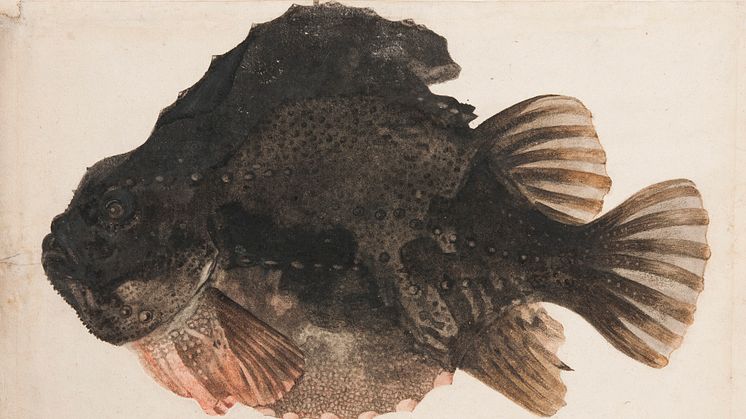
Press release -
New acquisition: Study of a Lumpsucker attributed to Hendrick Goltzius’ circle
Nationalmuseum has acquired a watercolour study of a male lumpsucker dating from the late 1500s. The drawing is closely connected with the group of nature studies executed by Dutch artist Hendrick Goltzius at around the same time. These were especially popular among contemporary learned collectors of art and naturalia. The newly acquired study is a significant addition to the museum’s important collection of Old Master drawings, and brings new perspectives on the group of autograph Goltzius’ drawings.
This expressive, life-size study of a male lumpsucker from the renowned collection of Professor I.Q. van Regteren Altena was long attributed to Dutch artist Hendrick Goltzius (1558-1617). In terms of technique, however, the newly acquired sheet differs from Goltzius’ nature studies, most of which are drawn in coloured chalks, with some wash. The drawing is, therefore, no longer considered to be a work by the Haarlem master, but rather by someone in his close circle. Executed almost entirely with a brush in watercolours and bodycolour, the new acquisition with its unique combination of transparency and opacity, renders the colour and special texture of the lumpsucker in a wholly realistic manner.
The lumpsucker, with its strange appearance and body shape, was generally regarded as a curiosity. The fish was, for example, represented in the collections of naturalia of the Theatrum Anatomicum in Leiden in the 1620s. Its thick skin lacks scales, and rows of wart-like lumps run the length of its sides and back, while the ventral fins form a sucking-disc on its stomach. The lumpsucker is found in coastal areas of the Atlantic. The fish is a poor swimmer and spends most of its life stuck in rocky crevices. The colour of its back is blue-gray, the sides are lighter. In the male the colours are at their most intense during the mating season, when its sides, stomach, and fins turn bright orange-red.
Naturalistic studies of animals and plants had become an established genre by Goltzius’ time, with precedents in the art of Albrecht Dürer and Joris Hoefnagel. To represent different aspects of the visible world was an important part of humanism, and inspired contemporary art collectors’ to fill whole albums with nature studies and their cabinets with valuable specimens. These activities became increasingly important in the Netherlands during the last decades of the 16th century. In addition to a growing interest in scientific pursuits, images of odd-looking creatures of all kinds could also have more negative associations to the occult. It is quite possible that the unusual appearance of the lumpsucker was interpreted as an ill omen.
The acquisition was made possible through a generous contribution from the Wiros-Fund. Nationalmuseum has no budget of its own for new acquisitions, but relies on gifting and financial support from private funds and foundations to enhance its collections of fine art and craft.
Press contact
Carina Fryklund, Senior Curator, Collections and Research, carina.fryklund@nationalmuseum.se, +46 8 5195 4475
Hanna Tottmar, Press officer, hanna.tottmar@nationalmuseum.se, +46 767 23 46 32
Caption
Hendrick Goltzius circle, Study of a Male Lumpsucker, the 1590s. Photo: Anna Danielsson/Nationalmuseum.
Categories
Nationalmuseum is Sweden’s premier museum of art and design. The collections comprise older paintings, sculpture, drawings and graphic art, and applied art and design up to the present day. The museum building is currently under renovation and scheduled to open again in 2018. In the meantime, the museum will continue its activities through collaborations both in Sweden and abroad as well as temporary exhibitions at the Royal Swedish Academy of Fine Arts, Fredsgatan 12 and Nationalmuseum Design at Kulturhuset Stadsteatern in Stockholm. Nationalmuseum has partnerships with Svenska Dagbladet and the Grand Hôtel Stockholm, and acknowledges the support of FCB Fältman & Malmén. For more information visit www.nationalmuseum.se.

